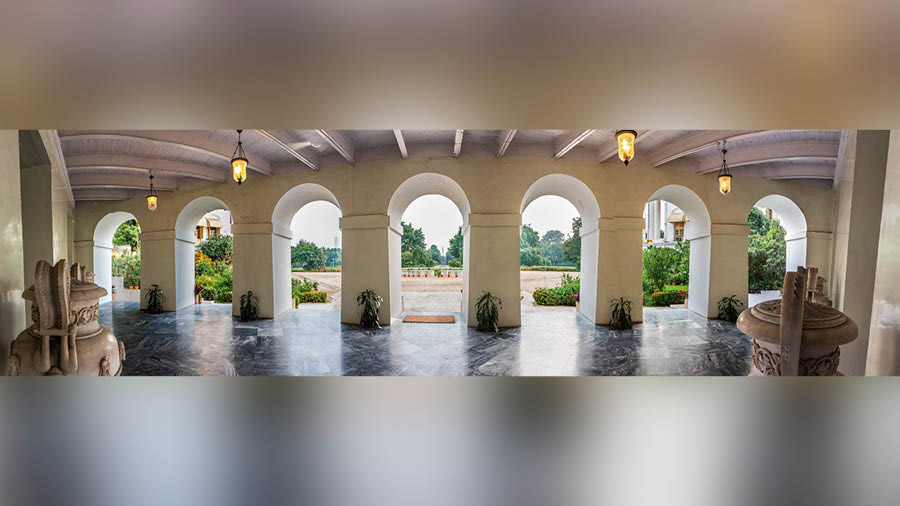As you cross the Red Road and Maidan, the regal gates of the Raj Bhavan are bound to catch your eye as you wonder what lies beyond those balustrade walls and majestic arched gateways. The Government House, as it was formerly known, was the official residence of viceroys, governor-generals and now governors of West Bengal.
As the majestic gates are thrown open for public viewing, My Kolkata spoke to Jayanta Sengupta, author of Those Noble Edifices: The Raj Bhavans of Bengal (2019), and asked about the five must-visit spots of the Raj Bhavan.
Exterior architecture
“The Raj Bhavan is one of the oldest buildings of such grandeur in Kolkata. It was completed in 1803 and modelled on the Kedleston Hall in Derbyshire which was Lord Curzon’s eternal estate. The building itself is shaped like an H, which is quite typical of many 18th and early 19th century estates of the English countryside,” Sengupta said.
The building follows a neoclassical style of architecture, complete with baroque features. “The seat of the administrative headquarters of other parts of the British Empire like Singapore and China were also in the Government House, now known as the Raj Bhavan.” added Sengupta.

South Verandah Panorama
The gardens
Sengupta said the Raj Bhavan, when originally built, did not have a garden. It started developing almost 50 years after the structure was built. “When the Raj Bhavan was built it didn’t have any gardens because people were expected to gaze at it [the building] and be awestruck from a distance. The gardens came later. I think Lord Auckland's sister, Emily Eden, planted the first trees on the campus almost 50 years after the Raj Bhavan was built.”
The gardens, Sengupta pointed out, hid the Raj Bhavan from public view. “You can’t see much of the Raj Bhavan from outside now because of the trees. But it was absolutely bare back in the 19th century and there are notes that Lord Canning in 1857 could be seen in the late evenings pacing very worriedly in the grand ballroom.”
Chinese-Winged Canon
As you approach the North Gate of the building, you will be greeted by a cannon at the bottom of the stairs. “This Chinese-Winged Cannon was used in the [first] Opium War from 1839-1842. Lord Ellenborough got it shipped from Nanking to Kolkata. It’s a piece of history of the British Empire and its commercialisation of agriculture. The whole story of opium has its footprints on the cannon,” Sengupta said.
Billiards Table
Interior architecture
The interiors, when opened to the public on special occasions, only comprised the first floor of the building. Sengupta mentions the Grand Ballroom where landmark occasions like Independence Day and Republic Day are celebrated; Yellow Drawing Room and Brown Dining Hall as well as the Council Chamber which served as the centre for many administrative decisions.
Throne Room
The Throne Room has an interesting bit of history. “It is called the Throne Room because it has a small stool that is believed to have been the throne of Tipu Sultan and was brought to Kolkata after Tipu’s defeat and death in the Battle of Seringapatam. But my research revealed that it was not Tipu’s original throne and the original throne was probably demolished. The intelligent guess is that it was probably a footstool with gold embellishments used to climb onto the back of his elephant.”
Artworks
The Raj Bhavan is home to several artworks by famous artists of Bengal. “There are some artworks that were commissioned during the post-colonial period. There is an oil painting portrait of Gandhi by Jamini Roy. There’s a painting of Indira Gandhi, which I believe was painted by Bikash Bhattacharjee. There is one of Atal Bihari Vajpayee, which was commissioned by former governor [and now vice-president] Jagdeep Dhankar,” said Sengupta.
Bonus pointers
Phaeton Garry (carriage)
Sengupta pointed to several important facts about the Raj Bhavan that make it one of the most important buildings in the socio-political timeline of West Bengal. “There are pieces of history strewn around different parts of the Raj Bhavan interiors. Kolkata’s first birdcage lift, a golden-colour lift, is present at the Raj Bhavan. I think Raj Bhavan was probably the first building to be electrified. There is also a ceremonial carriage. The Raj Bhavan archives has quite a few interesting photographs and documents like group photos with the first governor at the Raj Bhavan – Chakravarthi Rajagopalachari – around the late 1947 or early 1948; and photographs of Nehru with the Raj Bhavan staff.”
The lift
Those Noble Edifices: The Raj Bhavans of Bengal (2019)
Jayanta Sengupta in 2019 authored the book Those Noble Edifices: The Raj Bhavans of Bengal (2019), where he highlighted the Raj Bhavans of Kolkata, Barrackpore and Darjeeling and their several aspects.
“Raj Bhavan has a lot of history and it was part of the transition of India from the Empire jewel in the crown to the world’s largest democracy. It’s an important symbol of power and grandeur and if that is opened to the public that’s a welcome idea in principle,” Sengupta said.
Currently, the tour is open on invite only but is expected to be made open to the general public fully within the next two months.
*Disclaimer: The public access spots will be curated by the tours provided to the public during public access. Neither My Kolkata nor the commentator is responsible for the sights made accessible to the public.

